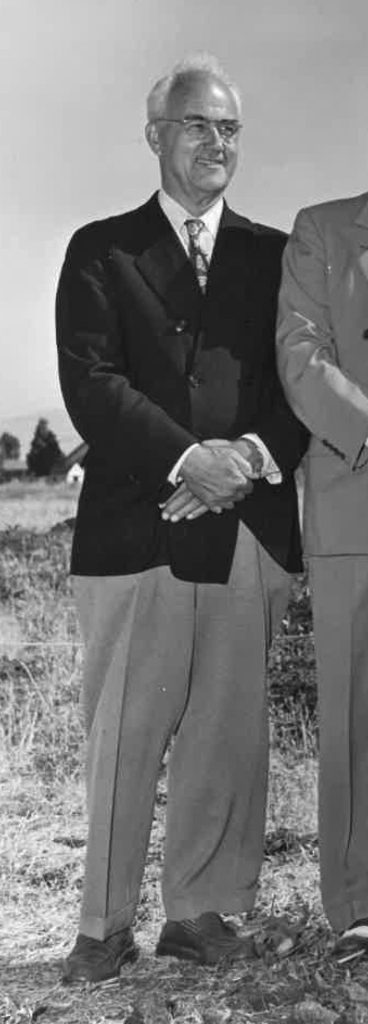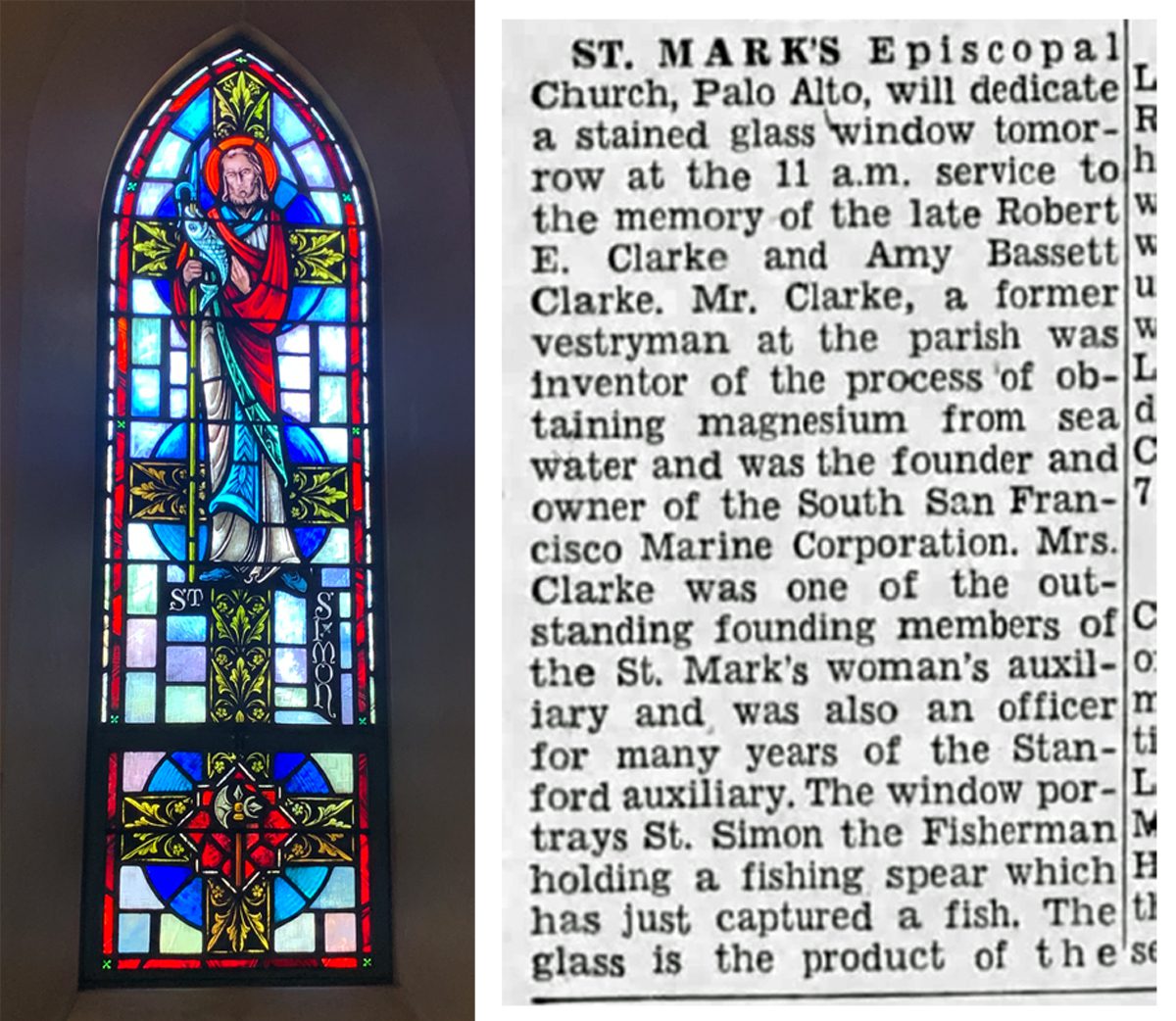the St. Simon window is located in the Gospel side of ST. Mark’s Church
the window was given in memory of Robert E. and amy Bassett clarke
the window was designed by cummings, cost $1046 and was installed in 1959.
Probably two of the most well known people in St. Mark’s history….a least from 1948-1957…were Robert E. Clarke. Robert and his wife, Amy Bassett Clarke. They were as responsible for St. Mark’s early success as anyone. Robert was the definition of a “self made” man and his story is pretty remarkable. He was an early example of the kind of entrepreneur familiar to us today.

Robert was born in Philadelphia. His father worked at various manufacturing jobs including “gold beater” (a person who beats gold into gold leaf). In what was the first of many tragedies in his family, Robert’s father was confined to an insane asylum in Chicago by 1900 (US Census). That same year Robert’s mother died. With his father in an asylum and his mother gone, Robert and his three older siblings were basically orphans left to fend for themselves. In 1900, the four siblings were living together and working. 16 year old Robert worked as a guard on the Elevated RailRoad.
In 1911, when Robert’s brother, William, was killed in a car accident in Hawaii. There’s not much information on Robert’s activities between 1900-1915, but somehow he ended up in “business” in the Philippines. It was in Manilla that he met Amy Bassett, a San Francisco debutante from a very prominent and wealthy family. The two married at Grace Episcopal Church in 1915 and Robert entered a whole different world.
After their wedding, the couple planned to return to the Philippines, but instead went to Russia. In 1920, they were living in Westchester, New York and Robert was a salesperson for a carpet company. Their only child, Harvey, was born in 1919. During the later 1920’s, the family moved to Salt Lake City and Robert continued to pursue different business opportunities. By 1930 they had moved to San Francisco near Amy’s family and Robert had begun to work for the chemical companies that made his fortune. In 1932, they moved to Palo Alto.
Robert’s fortune came from his invention of a process to obtain magnesium from sea water. He founded the South San Francisco Marine Magnesium Corporation. In 1951, he sold that company to Merck for over 2 million (about $23 million in today’s dollars).
The Clark’s had “made it” but the biggest tragedy lay ahead. Their only child, Harvey Bassett Clark, was killed in World War II. He was engaged to be married, but died when his ship was torpedoed on his 24th birthday. Amy’s only brother died a few years later. They threw themselves into work in the community and in 1948 became founding members of St. Mark’s…and some would say were the most important founding members of St. Mark’s.
Robert and Amy were present from the very first meetings to plan St. Mark’s. The minutes show he guided decisions ranging from purchasing of land to hiring architects to hiring the first Rector (he found Tanner Brown himself without benefit of a search committee). Robert later served on the Vestry as Senior Warden and in all different kinds of church leadership positions. During the parish’s first 10 years, the couple funded many different projects – mostly anonymously. They paid, for example, for parts of the Rector’s and Associate’s salaries, provided money for buildings and gardens and stained glass windows, and no doubt for many other things that were not recorded.
Robert and Amy’s contributions were acknowledged in the 25 Year Anniversary book:
“Robert helped to gather a grop of Episcopalians who observed teh urgent need for a parish in fast-growing South Palo Alto. He saw that tasks were taked up by capable people. He encouraged and pushed them to work faster, to do things that seemed difficult or impossible. He found way sto finance our early building programs. He personally paid for one year the salary of our first rector. He induced a builder to construct our first chapel before we could offer reasonable proof of financial responsibility. He paid the cost of one our Sunday School buildings. He paid half the cost of our Parish Hall….Amy Clarke shared fully in everything he did.” (St. Mark’s Archives)
But Robert Clark was a very strong personality, and the gifts did not come without something expected in return. He seemed to approach his volunteer work similarly to how he ran his company. The 1979 history of St. Mark’s described the Clarkes as follows:
“Robert Clarke as a rich and power man, a millionaire – president of his company, and chairman of the board too, with influence in several arenas. He was also a very determined man who rarely explained his actions, who listened carefully to the opinions of others, but with limited patience. It is also said he was aloof, enigmatic, brusque – a man who spoke quietly, yet always managed to be heard…and understood. A lot of important, creative events occurred while Robert and Amy Clarke were a part of St. Mark’s. They got things done and they saw to it that others did the same. There was a lot of money given to the church – anonymously – always enough, and never too much. He had a canny businessman’s eye for fiscal propriety. There were few who opposed him and chose to talk about it afterwards.” (St. Mark’s Archives)
Amy Clark died in 1952 (Palo Alto Times). Robert built a garden in her memory. He remained active at St. Mark’s, although less so as he got older and the church leadership did not always do things the way he wanted. He also traveled widely around the world and returned to the Philippines. He died in 1957. After his death it was discovered that he had changed his will and did not leave St. Mark’s a bequest he had promised.
Despite this ending, reading the early Vestry minutes and reports lead to only one conclusion…Robert and Amy Clarke should share a huge amount of credit for the early success of St. Mark’s. His business experience and expertise in particular guided the parish during the extremely rapid growth of the early years. Their financial resources helped the Parish to fund numerous projects that would not have been otherwise possible. They were truly key benefactors and founders for St. Mark’s.
After Robert died, funds were raised to remember the Clarke’s with a stained glass window. The St. Simon window was dedicated in February of 1959.



